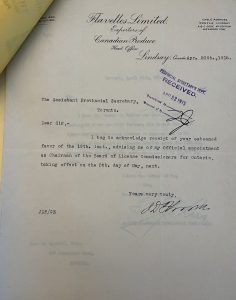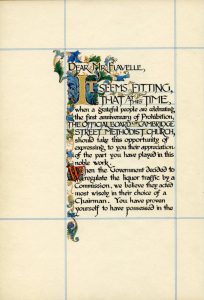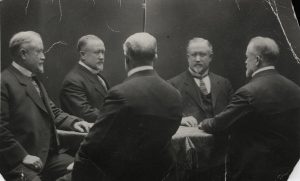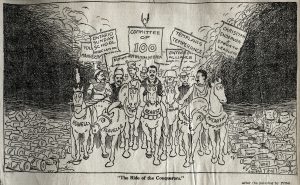Board of License Commissioners of Ontario
The Scott Act would prove ineffective as individuals could still get their hands on liquor in municipalities that were still considered “wet.” Ontario premier James Whitney was able to masterfully dodge the liquor questions by reforming the license fee structure and appease both the temperance workers and liquor interests.
Coming out of his short-lived retirement after selling his shares of the mill, J. D. Flavelle began working as a commissioner in Victoria County to regulate and enforce liquor laws. J. D. was soon seen as someone who was tough in administering the law, but was also very fair in the process of doing so. He never saw himself as a “temperance crank,” but rather a “good-natured temperance man” who wanted to serve his country where possible. An ardent supporter of James Whitney, J. D. — who never joined in the fray during election cycles — crisscrossed Victoria County in support of the liquor and license laws of the Whitney administration during the 1914 election; pointing out often that the opposition Liberals who ran a campaign on “Abolish the Bar,” were merely doing so to rebuild their flagging party and not at all interested in regulating and enforcing prohibition.
Whitney would unexpectedly die three months after his reelection in 1914 and was succeeded by William Hearst, who was seen by the temperance movement as a strong ally. Lacking any of the charisma and tack of his predecessor, Hearst and his provincial secretary abolished the present liquor and license administration and opted instead for a commission known as the Board of License Commissioners which would be made up of five men and would be set to take charge of the license branch of the provincial secretary’s departments and were given absolute control over it. Instead of having license commissioners in each electoral district, the province was divided up into six districts. Every license to sell liquor and consume liquor would be controlled completely by this Board with wide powers. It was the first real step by which the Government took a strong hand in regulating intoxicating liquors.

J. D. Flavelle’s letter to the Provincial Secretary’s office informing them of his acceptance to the position of Chairman of the Board of License Commissioners. April. 20, 1915.
It was announced on April 22, 1915 the make-up of the Board with J. D. Flavelle taking up the Chairmanship and being the face and spokesperson for the Board. No doubt, Flavelle’s actions during the previous campaign were noted by the Conservative government. He was a great speaker, respected, a lifelong Conservative member, and the older brother of millionaire Joseph Flavelle. J. D. took this position seriously and felt that it was his duty to serve the government when called upon, a position strongly supported by his brother William.
The Board of License Commissioners immediately began getting to work and by June, 1915, J. D. made clear to the public that by the end of the year, “a great many individuals” will feel disappointed. Flavelle continued to set out the functions of the Board by saying “while we have no desire to punish a man, the interests of the Province and the community which are at stake will always weigh much heavier than the interest of the individual.” It was a large undertaking for Flavelle to set up this commission and show the public that they were sensible and straightforward and would follow the law as prescribed, though their immense power to arbitrarily close shops, hand out licenses, draft and pass legislation without going to the Ontario Legislature, and directing a plain clothes secret police force meant that Flavelle and his board were arguably the most powerful civil servants in the Province.
On a quiet Saturday night, the Hearst government with the blessings from Flavelle and the Board, passed the Ontario Temperance Act which completely prohibited the consumption and sale of liquors in the Province of Ontario. There was the expectation amongst government officials that the passing and enacting of prohibition would cause unrest with the public in Victoria County, but none were observed by the License Inspector William Thornbury. The inspector was in Fenelon Falls on the night of the OTA passing and all shops were closed at the appropriate time and the odd drunk was seen roaming the streets. Take that with a grain of salt, as those who were caught drinking would have been prosecuted so they most likely hid on the night prohibition was enacted. Even so, J. D. Flavelle attended the Lindsay Fair with a visitor count of 15,000 people on October 5, 1916 and decried “there was not one drunk on the grounds” while in previous years, it took the police over two days to dispose of endless cases of booze.

Booklet given to J. D. Flavelle in 1916 by the Cambridge Street Methodist Church; one year after J. D. became the Chairman of the Board of License Commissioners. 1916.
Enforcing the Ontario Temperance Act when enacted in 1916 was a challenge, Flavelle admitted on multiple occasions before retiring in 1921. Although a majority stood for prohibition, Queen’s Park politicians were weak on implementation. Invoking his brother’s spirit, when the Conservative Party announced the end of prohibition in 1926, William left the party citing “principle over Party” in memory of J. D. who passed a year earlier.



